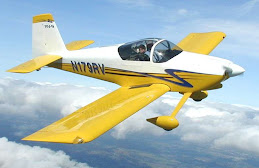Stripped plastic from around holes on the outside of the left HS skin. Deburred and dimpled holes. Deburred and dimpled the #40 holes on the main and nose ribs, both sides.
 Yesterday, I emailed Vans support about my problem with the slightly elongated holes in the nose rib. Today, I got an answer from Bruce suggesting that I just go ahead and use the part.
Yesterday, I emailed Vans support about my problem with the slightly elongated holes in the nose rib. Today, I got an answer from Bruce suggesting that I just go ahead and use the part.I also posted a question on the RV squadron about polishing the edges in the narrow slot between the tabs and the rest of the flange on the main ribs. I got a variety of suggestions from Scotchbrite pads to 2" Scotchbrite wheels to wet&dry paper. What a great support network!
This evening, I went back to the left HS skin, which was first out of the jig, to bring it to the same stage as the right. So, I stripped off the plastic along the lines of holes, deburred and dimpled. I find the deburring bit mounted in a hex adaptor in my electric screwdriver to be very fast as it is easier to position than the dog-leg manual type. I only need to press the trigger for the briefest moment and then lift off. As the deburring bit has three flutes, one third of a revolution in full contact with the hole is enough to completely remove the burr. It is actually very difficult to restrict the tool to this. I reckon I am getting about one full revolution at a minimum. Still, the holes do not seem to be over-deburred. A deburring bit with only one sharp flute balanced by one or two rounded polished flutes would be a useful tool but I am not about to divert my attention to alter my one and only deburring bit.
This was also the first use of my pneumatic rivet squeezer. I fitted the dimple dies and used it to dimple the rib flanges. It does a superb job very quickly. I need to be careful that the die is properly positioned as it would be so easy to punch trhough beside the hole. I would have preferred to reverse the male and female die but the only way I had space to fit them was with the male die on the plunger. This meant that I was fitting the male die into the hole before pulling the trigger and the work piece would move with the plunger as it travelled up to meet the female die. I would prefer if the work piece was stationery on the male die and the female die did the moving to close the gap (I know you are all thinking up smart double entendre remarks on this theme and all I can say is "Stoppit"!). Anyway, nothing went amiss and I ended up with 16 perfectly dimpled ribs. I even managed to carefully avoid dimpling the tabs on the main ribs as they match up with the inside of the spar flange, which will be countersunk and therefore do not need a dimple in the tab underneath.


No comments:
Post a Comment